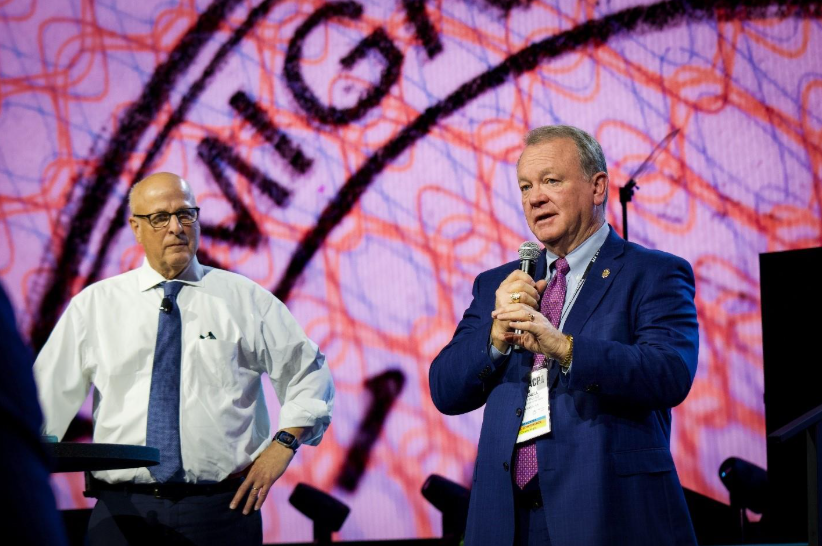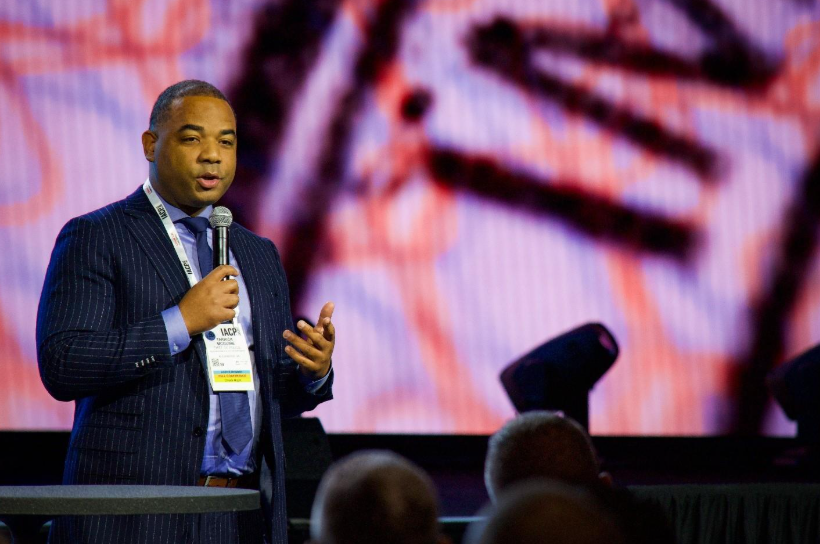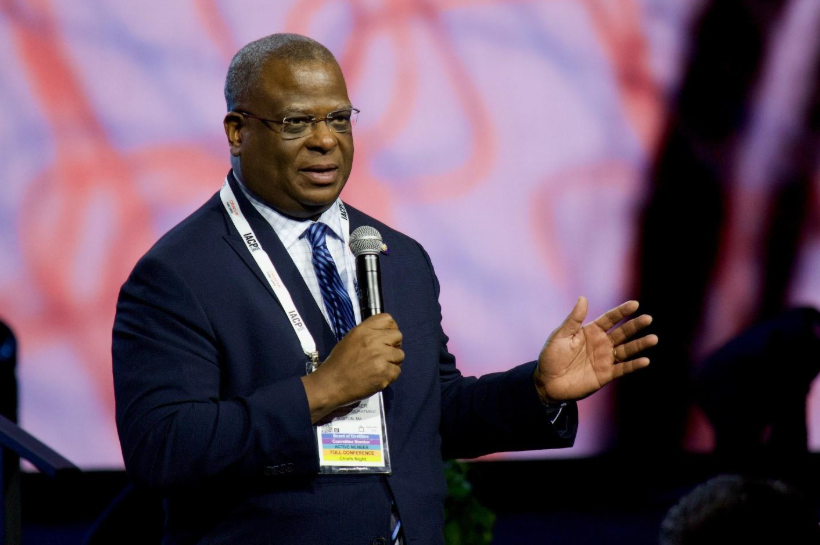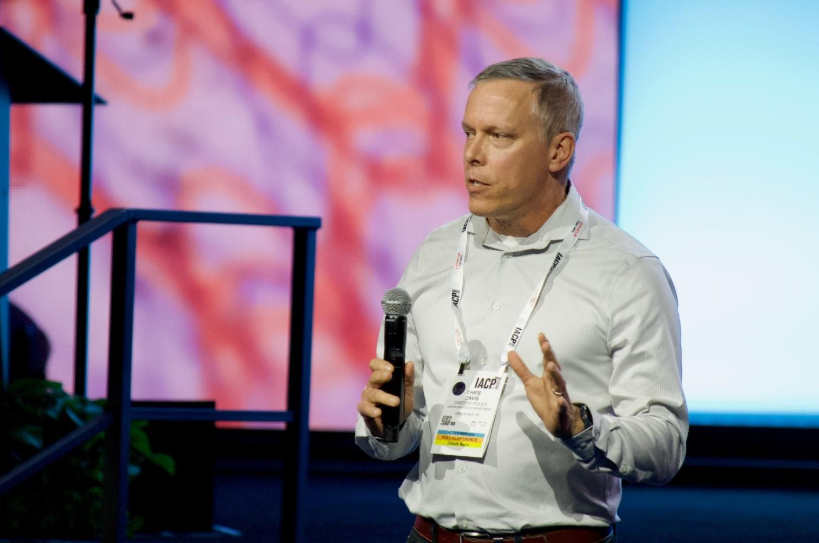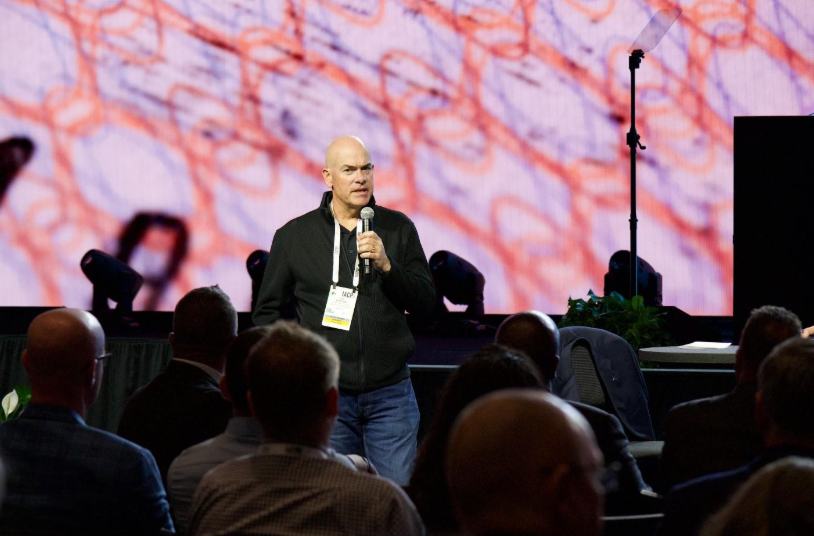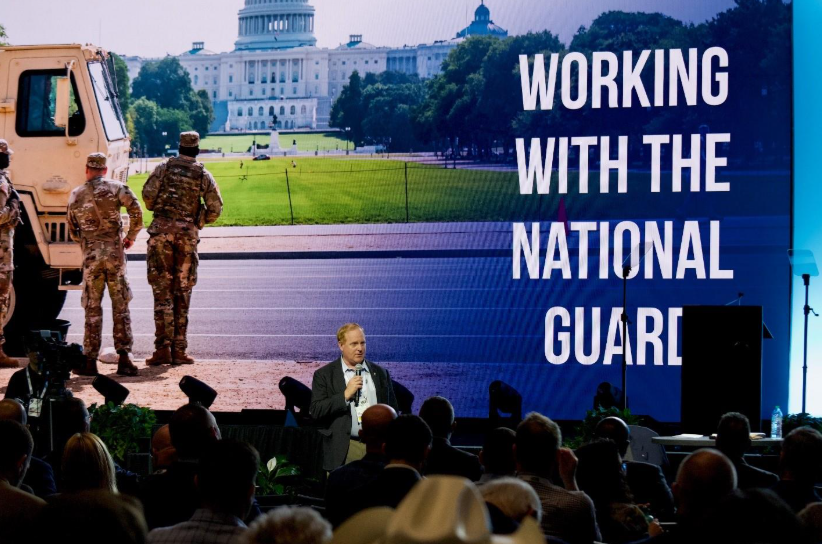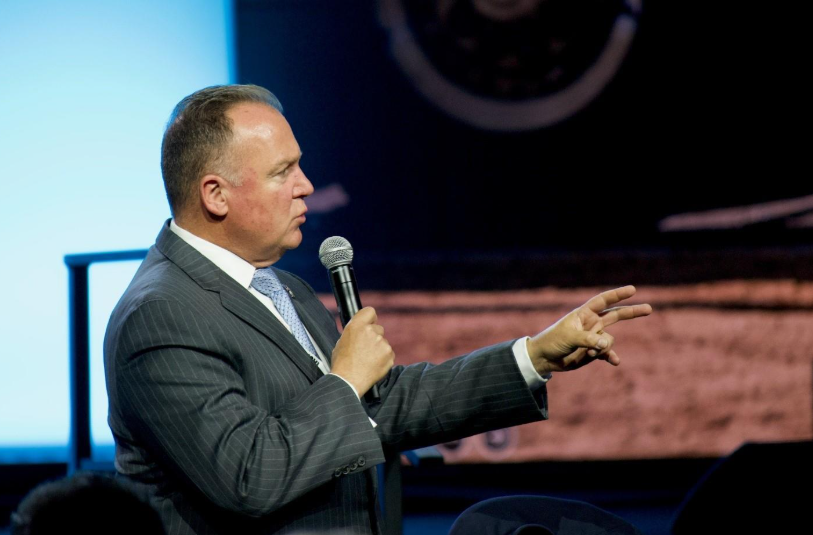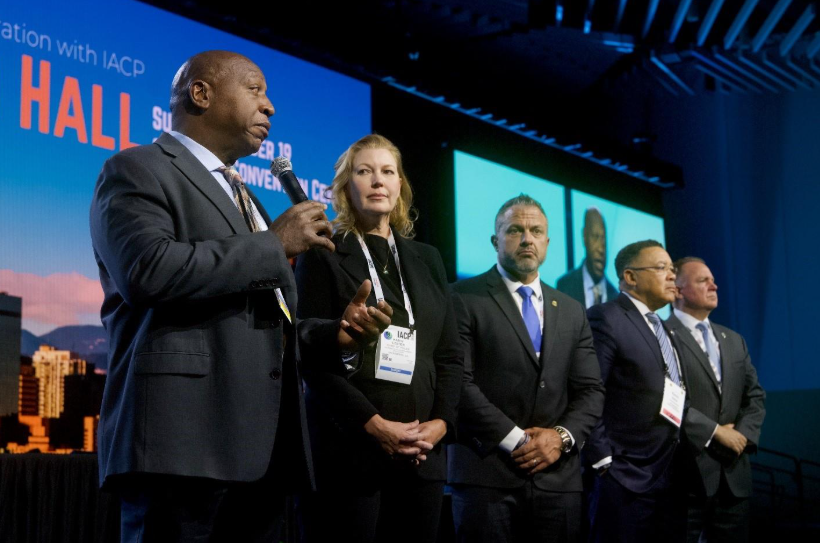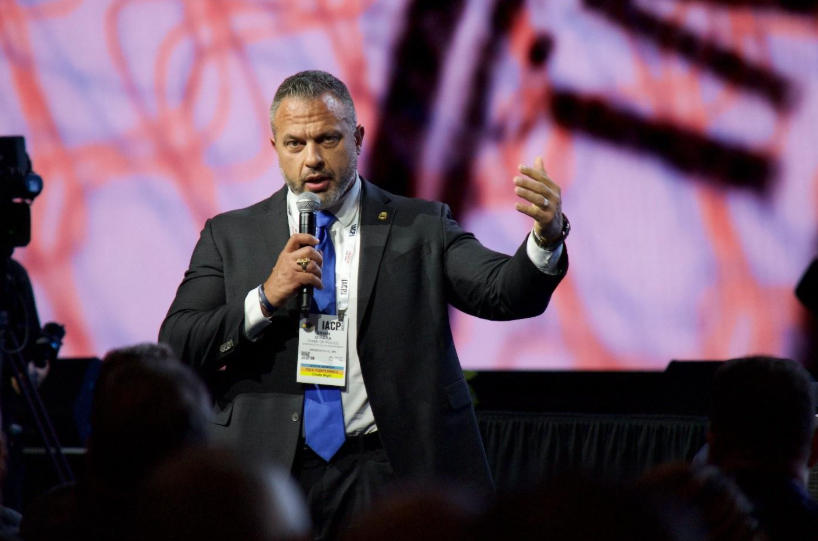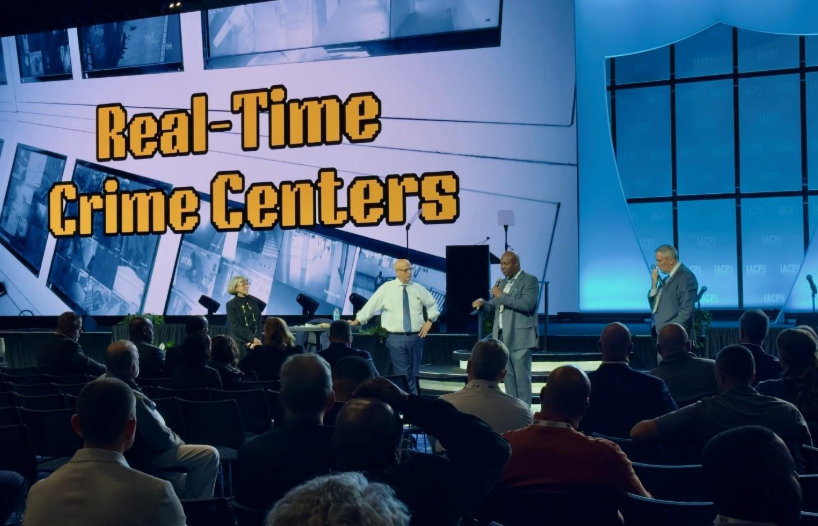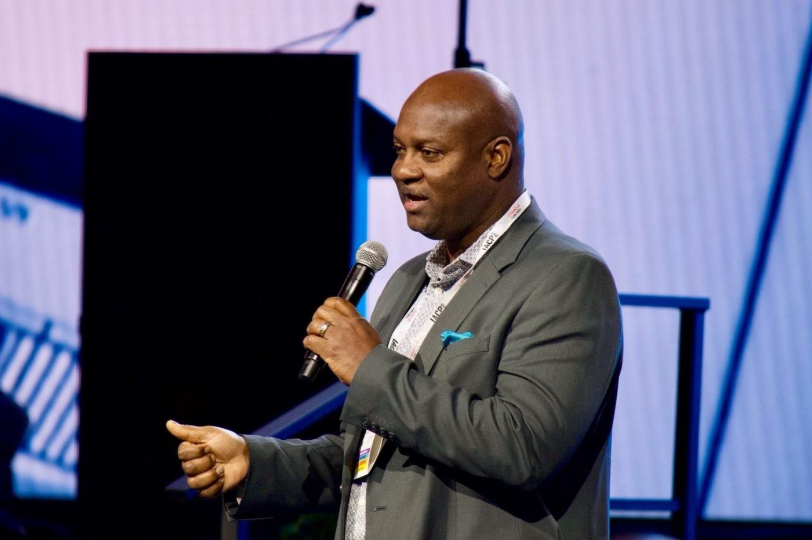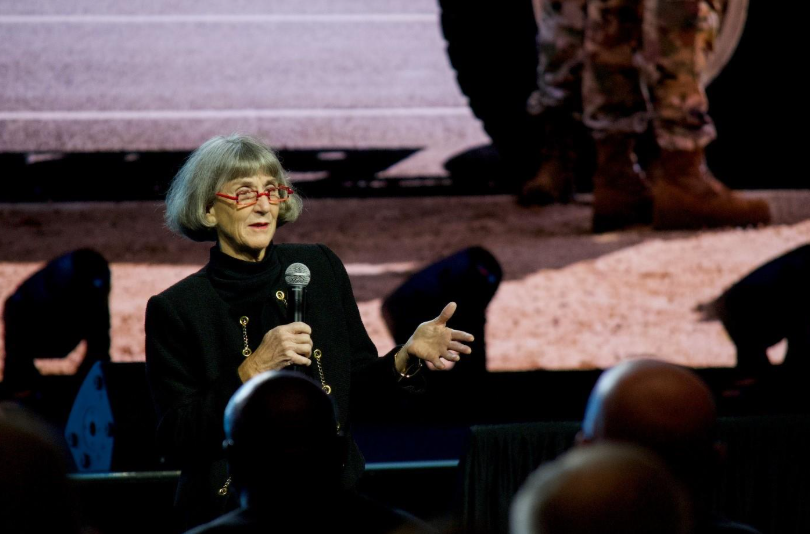|
October 25, 2025 Discussing the National Guard, immigration enforcement, school shootings, and real-time crime centers at our Town Hall Meeting in Denver
PERF members, Thanks to the many of you who came to our Town Hall Meeting last Sunday and stopped by our booth in Denver! Over the next few weeks, I’ll share some highlights from our Town Hall discussion, starting with our members’ comments on National Guard deployments, federal immigration enforcement, school shootings, and real-time crime centers.
NATIONAL GUARD AND IMMIGRATION ENFORCEMENT LAPD Chief Jim McDonnell
Chuck Wexler and LAPD Chief Jim McDonnell.
I think what you’ve seen in the media is not exactly what it’s been like on the ground. The media has painted a picture of the National Guard coming in, working the streets, doing the LAPD’s job on the streets, and that hasn’t happened. In Los Angeles, when the National Guard and 700 Marines were deployed, their actual mission was to protect federal employees, federal property, and federal functions. So they got out there and they were pretty much at two different federal buildings on two different sides of the city. They were protecting entry into those buildings from sometimes very violent protesters. Our job was on the street, and we would respond. We got calls over and over again for “kidnap in progress,” and we’d get there and it would be federal immigration agents doing their jobs. We would send sergeants along with the responding units, and they would get there, determine that this was an enforcement action by ICE agents or others brought in to do that, and then keep the peace. In order to do that, oftentimes our folks put a skirmish line up between the crowd that was forming and the agents doing their work. We were painted by some as enabling ICE agents and working with ICE, and criticized by others for not helping ICE. It was one of those situations where no matter what you did, it didn’t seem like you were going to be right overall, but we did the right thing. We kept the peace, stayed the course, and didn’t get political on one side or the other. We just responded, and our focus was solely on public safety. Alexandria (VA) Chief Tarrick McGuire
Alexandria Chief Tarrick McGuire.
If you’re really not close to the border, you’re really not dealing with immigration issues as much as you would if you were in the South. In Alexandria, it started off with a text message: “Chief, ICE is here. Do you know ICE is coming to town?” My response was, “No, I don’t.” But I shared that the federal government has the ability to do immigration enforcement. And we, as a local police department, have a responsibility to remove criminals from our community, so we will continue to enforce warrant services with our task force personnel. Every time we run a warrant, my phone will blow up. What I’ve learned is that every time we run a criminal warrant, as soon as it seems safe, our officers knock on doors in the community to notify everybody about the criminal warrant. We also share on social media that it has been a criminal warrant. Even with all those efforts, there are still some questions about whether you’re doing immigration enforcement. So it’s been a very challenging issue. Boston Commissioner Michael Cox Boston Commissioner Michael Cox. In Massachusetts, it’s the law that we can’t do immigration enforcement, and that’s the law we follow. In communities that have laws that say local police can’t enforce immigration, it’s being portrayed that we’re weak on crime and releasing these people to go out the back door and pillage our community. That’s not the case at all. It’s the system we work in, and that we’ve always worked in. Green Bay (WI) Chief Chris Davis
Green Bay Chief Chris Davis.
We have very longstanding relationships with our Latino community. In the last 20 years or so, the city of Green Bay has experienced really rapid diversification. It used to be about 97 percent white. Today, 16 percent of our population is Latino, and we have a significant Hmong population and other refugee groups that have come from around the world. We have tried to engage everyone in this conversation. I have people in my community who are very concerned with what they perceive to be issues with immigrant crime. Our discussion with them is grounded in data. In reality, that’s not a problem we have. I don’t know what’s going on in other places, but for us, that’s not really an issue. With our Latino community, thank goodness we undertook to build a Latino Advisory Council for the police department before this all started. If anything, this situation has made the police and the Latino community even closer. We’ve gone out in the community and told people how it really is—the good, the bad, the things we like, the things we don’t. At least we’re grounded in reality. So our strategy has been to engage with everybody on the issue, and so far it’s worked. Tampa (FL) Chief Lee Bercaw
Tampa Chief Lee Bercaw.
The state passed a law that made it illegal to be in the country illegally in Florida. That law was overturned by the Florida Supreme Court in July, and during that whole process there were debates back and forth between the attorney general and attorneys about whether we enforce that or not. So there was some confusion for our officers during that time. Every agency in Florida was encouraged to be part of the 287(g) program, and we did it. There was a little community backlash to it, but we told them exactly what we were going to do and how we were going to do it. About 25 percent of our community is Hispanic in Tampa, and when you have the community’s trust, they look at you, believe you, and appreciate that conversation. So far, I’ve trained six officers in 287(g), and we haven’t received any instructions on what to do with them. The whole state, from sheriffs to police chiefs, is consistent in saying that anything we do is to address people who are criminals. So it’s definitely a political landscape. The biggest thing for me is to keep that confusion away from the officers, to keep their jobs as simple as possible, and for the community to understand what we’re doing and why we’re doing it. Lincoln (NE) Chief Michon Morrow
Lincoln Chief Michon Morrow. We are very respectful of our federal partners, and we enjoy strong relationships with them. That’s been unchanged for us. In our community, we have very, very strong relationships. We’ve been a community-based policing organization since the early ‘70s, probably long before that was a term. So we built very, very strong relationships. It was interesting, because the request of me to make a statement to our community about how we were going to engage with immigration enforcement actually came from within our own walls. It was our officers in my office and talking to our command staff, asking if I had made a public statement. They were concerned that their relationships were going to be negatively impacted by any potential decisions coming out of my office. So we did make a statement and, of course, it was also for the community. But it was interesting that in our department it was really for our officers, who wanted to hear that we were still committed to community policing and the relationships we built, and that I was going to stand behind them and make sure they had all the tools and resources to be able to continue to do the job. Sacramento (CA) Chief Kathy Lester
Sacramento Chief Kathy Lester.
In January, we posted our position on immigration enforcement. In California, we have the California Values Act, and that’s very, very descriptive and prescriptive about what local law enforcement in California can and can’t do in a way that’s very helpful. Because there’s no grey area as to what local law enforcement can do. But it’s also putting all of us in a really tricky situation.
So we put the state law and our policy on social media. In my four plus years as chief, that was probably the most divisive post we had put out as a law enforcement agency.
We are living in much different times now, and I think that this is not going away. This isn’t something that’s going to change. All of us police leaders have a responsibility and commitment to our communities to protect everyone equally. That has been our position, and a lot of us are taking heat for it. It is even more imperative to know exactly what our moral compass is and what we are trying to do.
I also know that this is a new era of sensitivity. A few weeks ago, our SWAT team was training in a residential area. We do this all the time. We had a local housing project that was under construction, so our team went out to train there. A year ago, this would not have been an issue. But we had people responding because they thought ICE was in the area doing an immigration raid in our local neighborhoods.
So things we’ve done for many, many years are changing, and we have to be really sensitive. Part of our job now is to be very forward thinking and do that additional communication.
Portland (OR) Chief Bob Day
Portland Chief Bob Day. I don’t think that the National Guard deployment is going to be that big a deal for Portland. We have stressed and emphasized that these are our neighbors, our friends, and our colleagues. These are citizen soldiers who are answering the call and the oath that they took. We are trying to emphasize that the positioning of the Guard is not an escalation in our minds, and we really hope that’ll be the case.
When I speak to the National Guard, and as I’ve said publicly, it’s not that I don’t want them. I think they are a huge resource and could really benefit the city of Portland and Portlanders. My argument is that we don’t need them, and it feels as if this is an attempt to disrupt the community and cause the perception of chaos. That’s the part that disappoints me, because we all have a responsibility to police our communities and support our communities.
This grand experiment called the United States is really unique. In Oregon, I can only drive 70 miles per hour. In Idaho, I can drive 80. It’s not because Oregonians are scared and we don’t think we can handle driving 80. And it’s not because people in Idaho are better drivers so they drive 80. It’s because those states—those communities—have decided how they want to be governed. In Oregon, our community has said, “This is how we want to be governed. These are the laws we want. This is the kind of policing we want.” So it’s very challenging right now to police our community in the way they’ve asked to be policed with this massive amount of pressure and expectation that we police differently with different resources.
St. Louis (MO) Metropolitan Chief Robert Tracy
St. Louis Chief Robert Tracy.
We’ve had the National Guard come to our city two times since I’ve been chief, both this year. One was for a tornado in July. And then we had them for the last “No Kings Day” in June. I’ve also done this in Wilmington, Delaware.
The police chief is in charge and coordinates, and that’s one of the agreements we have with anybody who’s brought in, especially the National Guard. Our governor has told our mayor that the police chief is in charge and will be guiding, working with everyone else.
I was recently asked by a state representative if I want the National Guard. I said, “It doesn’t make a difference what I want.” But I said that if it does come here, I’ll have a plan to integrate them with what I want to do. Because if you don’t know what they’re doing, they might do things that interrupt strategies you have in place.
I’m down 400 police officers, so I’ll put them at critical infrastructure. I’ll put them at some of my crime scenes. I’ll put them downtown. I’ll put them in drug neighborhoods. I’ll have them stand out there, and we’ll continue to take care of business.
SCHOOL SHOOTINGS
Metropolitan Nashville (TN) Chief John Drake
Nashville Chief John Drake and the other members of the PERF Board.
A takeaway from the Nashville school shooting [in March 2023] was that it’s something that impacts communities way beyond the incident itself. When I looked at the Covenant School incident, the person more than likely drove by the school my grandson goes to less than five miles away. We began training for active shooters and school shootings years ago. I’ve been through it. Our police department went through it. We train by pulling people together, put them in teams, and train them to do it. The first officers who went into the Covenant School had never worked together a day in their lives. They just happened to be in the same area at the same time. They went and did what we trained them to do. And there were maybe 20 or 30 additional officers who risked their lives to go into that school. I went to every funeral of those who were killed. The kids were coming up to me saying, “Thank you for your service.” I was crying and I realized they had a stronger faith than I have, because they believe that their loved ones were going to a better place. All of us were crying and trying to figure out how we got to this. Minneapolis Chief Brian O’Hara
Minneapolis Chief Brian O’Hara.
Kids going to school have drills that they have to do for active shooters, so wherever they go, they think about this. In our case, little kids going to Mass at the Annunciation School, and they trained that when something like this happens—a shooting and the principal calls out a code signal—an older kid should jump onto a younger kid’s body. That’s what these kids are trained to do. That’s disgusting.
I can’t say enough about the response of the first officer there, Lieutenant Ryan Kelly, and the other first officers who responded. He got there, immediately went in, started dealing with the shooter, and gave direction to the other officers. Within 14 minutes, the police officers had everyone injured treated and in an ambulance.
I think we did well in terms of officer health and wellness. We were very intentional about having health and wellness and psychologists respond out and getting the 73 officers who responded all relieved as quickly as possible.
REAL-TIME CRIME CENTERS
Virginia Beach Chief Paul Neudigate
Virginia Beach Chief Paul Neudigate (far right).
Our [real-time crime center] has only been in existence for almost two years. It’s a $1.8 million investment, operating seven days a week, 24 hours a day.
One unique thing is ours involves civilians. Initially we wanted a hybrid model, but with staffing challenges, we realized that wasn’t going to happen. We’ve been able to make it work with nine civilian employees and a civilian supervisor.
I think at one time we believed that this was a luxury that would improve effectiveness and efficiency. But really it’s the hub for technology. If we invest in more technology, it’s a necessity.
Kansas City (KS) Chief Karl Oakman
Kansas City Chief Karl Oakman.
We emphasize that our real-time crime center is real-time. We have analysts right there on the dispatch console, so as calls come in, they send information from cameras, gunshot detection, and drones as first responders. It’s all tied in, and every officer has a department smartphone with apps that are integrated with the real-time crime center.
It’s been a big game-changer for our department. We were kind of lost on technology. Now we have other agencies coming to us to model our real-time crime center.
New Orleans Superintendent Anne Kirkpatrick
New Orleans Superintendent Anne Kirkpatrick.
The real-time crime center in New Orleans is actually under the city office of homeland security. It is staffed 24 hours a day, and we have officers in there along with professional staff. There are about 5,000 cameras in the French Quarter. The biggest question, which might be something for the next Town Hall Meeting, is whether or not we use facial recognition.
Thanks to everyone who participated in the Town Hall meeting in Denver! Judging from the feedback I have received, attendees found it to be one of the most spirited meetings we have had in years. The change of government here in Washington has ushered in significant change to immigration enforcement and introduced the military into several cities across the country. These policy changes at the national level are altering the traditional role of local police.
One of the most contentious Town Hall discussions was a debate between the authors of a recent study of the Force Science Institute, as well as representatives from FSI itself. We will be writing about that in two weeks.
And I want to share the video we showed to open the meeting about recent news related to crime and policing. That video is available here.
Best,
Chuck
|

